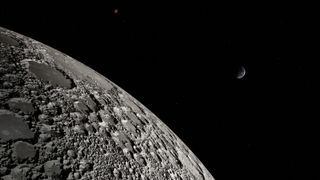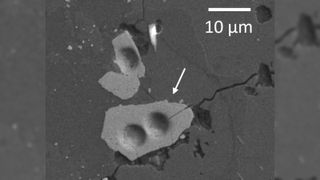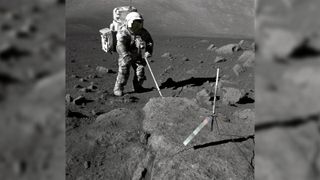
The true age of the moon just became a little clearer. In a new study, scientists show how a massive "remelting event" may have reset the age of almost all lunar rocks, tricking scientists into thinking our planet's constant companion is younger than it is. However, the moon's exact birth date remains a mystery — and could elude us for a while yet.
The moon formed in the solar system's early days when a large protoplanet named Thea slammed into a baby version of Earth, creating the planet we know today and ejecting enormous masses of molten rock into space. The ejecta became trapped in orbit around Earth before cooling and condensing into the satellite that currently circles our planet roughly 239,000 miles (385,000 kilometers) away on average. Scientists initially believed this happened somewhere around 4.35 billion years ago, based on the age of lunar samples recovered during NASA's Apollo missions.
However, reanalysis of Apollo samples has recently revealed tiny structures, called zircon crystals, within some of the rocks, which are much older than the rest of the sample material. In 2017, one study estimated that some of these crystals could be up to 4.51 billion years old, which is only around 30 million years younger than Earth. And in 2023 another study proved that other crystals date back to at least 4.46 billion years ago.
The great lunar 'reset'
In the new study, published Dec. 18 in the journal Nature, researchers propose a new explanation for why these crystals are much older than the lunar rocks. Using computer models, the team showed that the moon likely experienced a remelting event, which transformed the lunar surface back into molten rock before cooling again, forming the crystal-laden rocks that were collected during the Apollo missions.
"When these materials were heated, their internal clocks were reset to that time," study lead author Francis Nimmo, a planetary scientist at the University of California Santa Cruz, told Live Science in an email. "But some near-surface zircons never got heated up and reset, and so retained the older ages."
Related: 15 incredible images of Earth's moon

The remelting event also explains why there are fewer impact craters on the moon than scientists would expect if the moon was older than 4.35 billion years old, because any craters from before then would have been wiped clean by the remelting, researchers wrote in a statement.
The idea of lunar remelting was first proposed by scientists in 2016. But the theory has received little attention since then.
In the new study, the team suggests the event could have been triggered by "disorganization" in the moon's orbit around Earth as the satellite got caught in a gravitational tug of war between our planet and the sun. This disorganization was likely triggered as the moon began to drift away from Earth, which it is still doing to this day. And it could have happened more than once.
"It may have happened a couple of times," Nimmo said. "Once, when it was very close in, and then once when it was a bit further out. After that, things calmed down."

The remelting would have been a gradual process with rocks mainly being superheated just below the crust. The moon's surface would have looked largely similar throughout the event, as any magma that erupted at the surface would have quickly cooled and solidified due to the extremely low temperatures of space, Nimmo said.
While the new study supports the idea that the moon is older than previously thought, it doesn't shed much light on an exact age. The researchers estimate that the moon could be anywhere between 4.43 billion and 4.53 billion years old, which is around the same level of uncertainty as previous studies.
However, 4.53 billion years is almost certainly the upper limit. "If you push it much earlier then you run into the problem of the moon being older than the Earth, which would be hard to explain," Nimmo said.
A true age for the moon could be revealed in the future by analyzing more lunar samples, like the ones China's Chang'e 6 mission recently brought to Earth from the moon's farside. However, even then, it is unlikely that we will ever be able to definitively pick an age with less than 5 million years of uncertainty either way, Nimmo said.


评论(0)